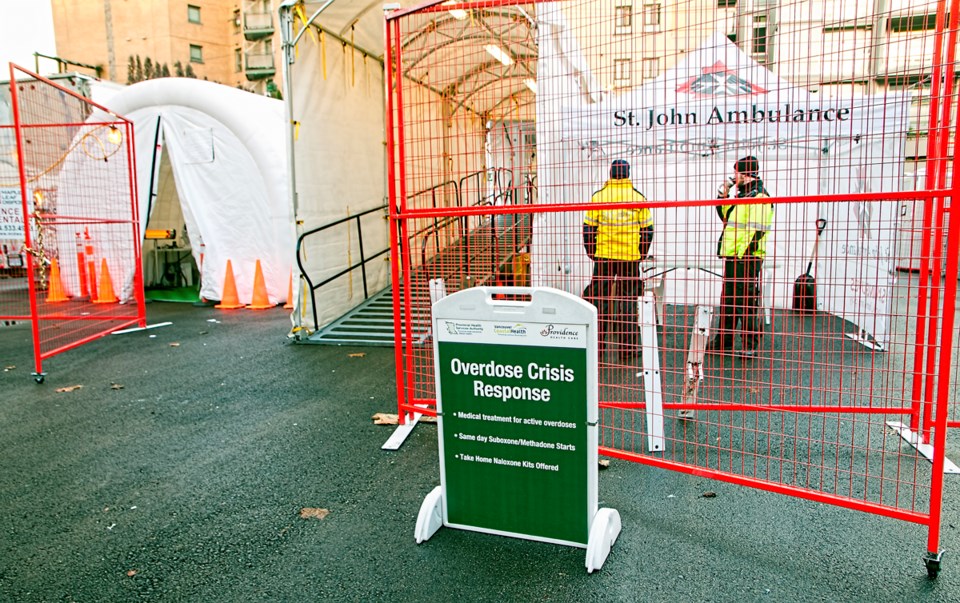As this year draws to a close, I’m willing to bet that 12 months ago most of us had never even heard of the synthetic opioid fentanyl.
The drug was developed in 1959 and has been often used in the form of a patch to relieve severe pain experienced by cancer patients.
But according to the executive director of the Canadian Drug Policy Coalition Donald MacPherson, fentanyl and its use has become the latest “product of drug prohibition.”
Criminals have figured it out. An amount equal to a grain of salt when mixed with cocaine or heroin can give the addict more bang for their buck and too often have deadly effects. A package the size of your fist shipped here from China is worth a small fortune on the streets.
And this serial killer has been increasingly peddled to addicts throughout B.C. and across the country for four or five years now. Those courageous and committed folks who work to prevent deaths caused by drug overdoses have watched the number of fatalities climb and have pushed for more supervised injection sites like Insite.
But their efforts were thwarted by a Harper-led federal Conservative government, first in the courts and, when they failed there, with a piece of legislation, “The Respect for Community Act.” That legislation established insurmountable barriers to harm reduction that only led to more misery and death.
There has also been a steady and building movement advocating the decriminalization of drugs particularly since the cause of “harm reduction” was taken up by former Vancouver Mayor Philip Owen 15 years ago.
Since then there have been two Vancouver-based projects dealing with heroin addicts: “Naomi” and “Salome.” Both provided addicts with regular doses of pharmaceutically pure heroin or hydromorphone in a controlled environment described this way: “Throughout the treatment period, an interdisciplinary team of physicians, nurses, social workers and counsellors are available to help participants achieve stability in their life, seek employment and find suitable housing.”
As a result, lives stabilized and criminal activity declined. But the federal government’s refusal to go any further has meant that those studies have been left to gather dust while the death toll among addicts — particularly thanks to fentanyl entering the scene — has soared. In British Columbia, there were 480 overdose deaths in 2015 and 755 for the first 11 months of 2016.
In April of this year, B.C.’s Medical Health Officer declared a state of medical emergency. On Sept. 20, the day before folks received their welfare cheque and many on the Downtown East Side fell prey to drug dealers, former park board commissioner Sarah Blyth and long-time drug addiction advocate Ann Livingston erected a “pop-up clinic” of sorts to help prevent overdose deaths.
It took the November figures on deaths to actually jolt the provincial government and Health Minister Terry Lake to start funding and authorizing more supervised injection sites even though those sites failed to meet the criteria under the existing federal law.
And while on that subject, it took the Trudeau Liberals a year after their election to introduce Bill C37, which will roll back Harper’s Respect for Community Act and replace it with conditions for opening up a supervised injection site more closely aligned with the Supreme Court of Canada’s ruling. That act has still to be passed. And even then it will take time to have an effect.
Meanwhile, Vancouver city council at its last meeting approved a 0.5 per cent hike in next year’s property tax to assist the city’s first responders in meeting the growing crisis of overdose deaths in the city.
Yet, I can’t help but think if fentanyl was a virus killing people and not a controlled drug, governments would be doing much more to mitigate its effect.
I agree with advocates who have been saying for years now that we need to change the laws around controlled drugs, stop criminalizing drug use and treat addiction as a health issue.
Portugal is often cited as a country that has followed this path. And what they have found is that drug-related deaths are down as is criminal activity and all the costs related to those activities.
Failing that, the numbers of fatalities is likely to grow as that serial killer continues to rack up its victims.



